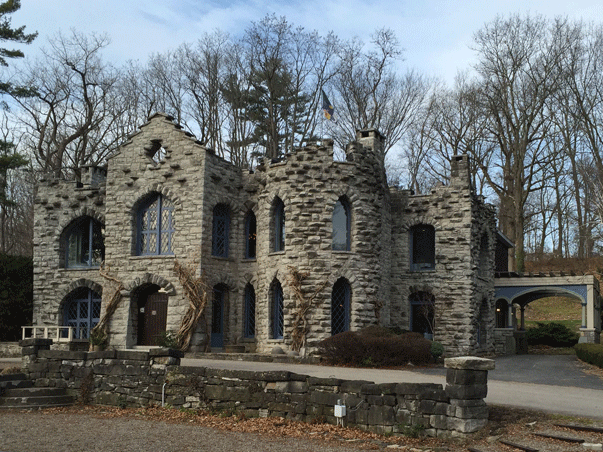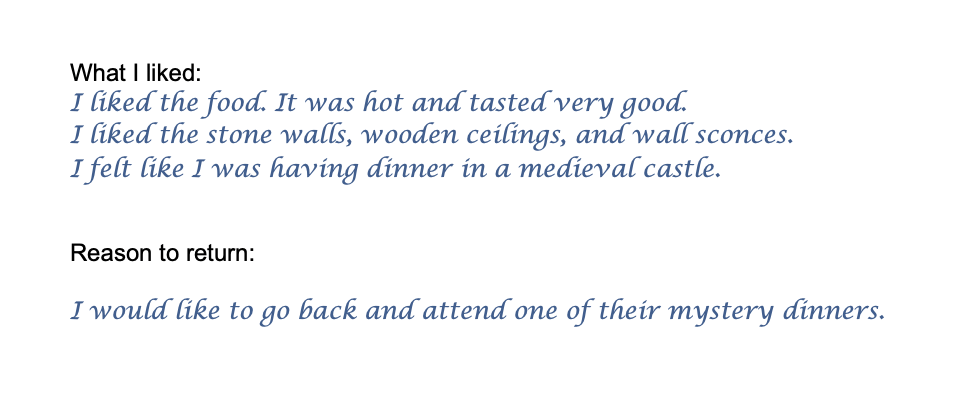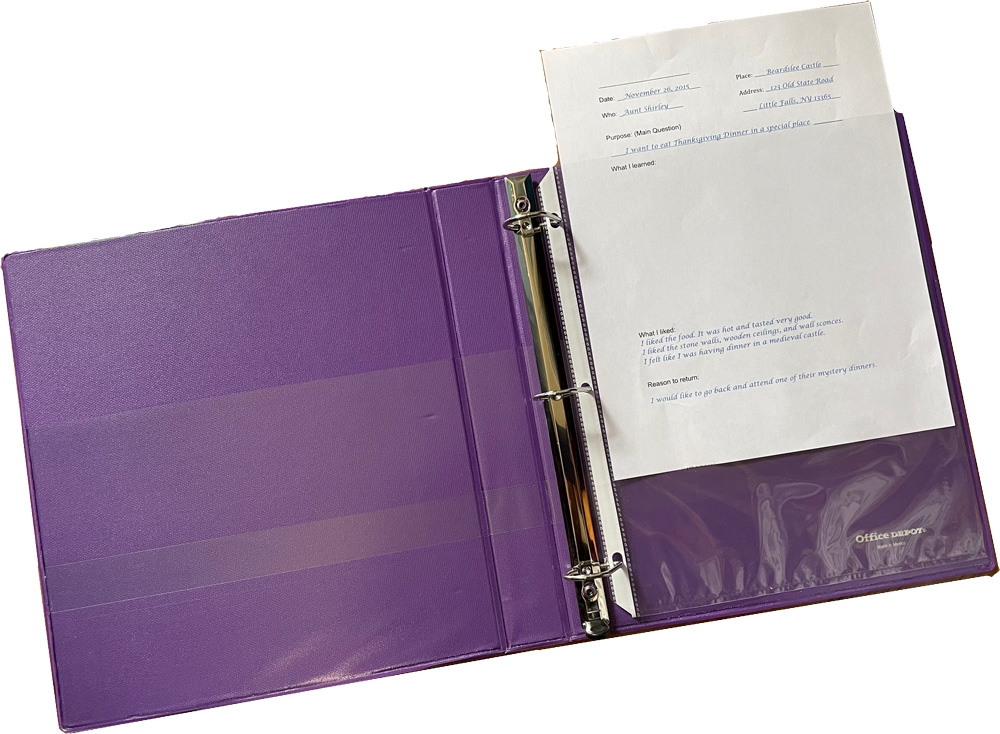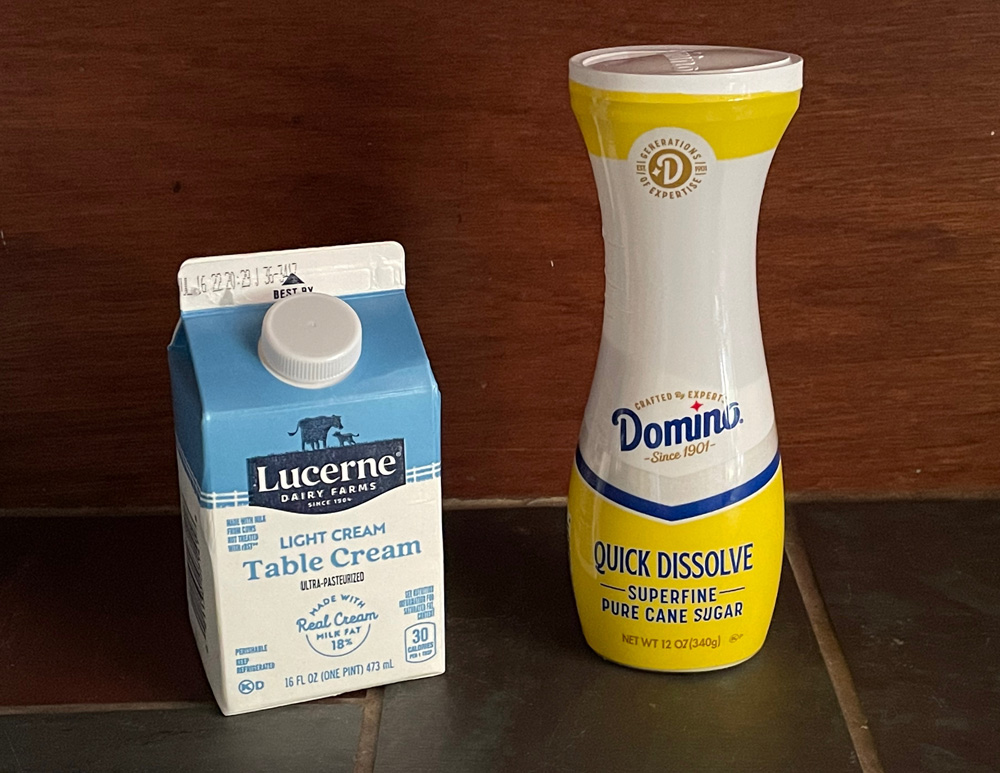
Creating a record of the field trips that you take with your children increases the value of the field trip. This can reinforce what they learn and can be used as a reference for later work or visits.
In order to help your children keep a record, I created a simple journal entry form. In this activity, I demonstrate how to used the form.
I also included a bonus activity. Since this field trip was to a medieval castle restaurant, I decided that I could extend my experience by creating a medieval dish to eat at home.
Activity Demonstration
Keeping a record of your trip to a special restaurant will help to preserve the long-term benefits of the trip.
In a previous lesson, I described how to created a binder for the journal entries. If you want to read that description, go to Welcome Activity.
Before the field trip to the Bearsdlee Castle, I printed a copy of the Field Trip Journal Entry Form.


Then on the line beside the word “Place,” I wrote the name of the place that I was visiting, Beardslee Castle. I recorded the date and address of the restaurant. I wrote my name on the line next to “Who.”
Next I thought about why I was going to the Castle. The main reason that I chose to go to Beardslee Castle was to eat Thanksgiving dinner in a special place. I wrote this on the line under “Purpose.”
After the trip to the Beardslee Castle, I recorded on my Field Trip Journal Entry Form what I liked about the experience. (I think it is important to be positive.)
I thought about reasons to return some day. (If I had had a bad time, I would mention here that I would not like to return.)


The last thing I did was to slide my journal entry into a sheet protector and put the sheet protector in my journal binder.
Activity Directions
Materials needed
- 3-ring Field Trip Journal Binder
- Sheet protector
- Field Trip Journal Entry Form.
- Ingredients for the Rose Pudding (See below, if you have decided to make the pudding.)
Pre-Trip Activity
- If you don’t live in the New York area, you could find a special restaurant near you. Your choice might be an unusual building, like the Beardslee Castle. Perhaps it is a restaurant that serves a type of food that your children have never tried. Explain to your children that this is not just a time to go out and eat. It is supposed to be an educational field trip. It is a time to experience something new.
- Talk about what to expect at the restaurant. Look at pictures of the restaurant from the restaurant’s website. Read the menu with your children. What foods do they wish to try?
3. Download and print the Field Trip Journal Entry Form. You may print as many as you need for your children. Have them fill in the top part of the form, including their purpose or personal reason for going to the restaurant.
Field Trip Journal Entry Form
Download and print this PDF Field Trip Journal Entry Form by clicking on the button below.
During the Field Trip Activity
- Encourage your children to ask questions about the food on the menu. If the decor is different, they might like to ask about the decor. You might like to ask for a tour of the restaurant.
- I suggest that you order a couple of new dishes and share the food among your children (on separate plates.) Then order a couple of dishes with which your children are familiar and share those. This way all the children get to taste and discuss the same new foods. Discussing the taste of the food will encourage your children to try the new dishes as an experiment.
- If you feel comfortable about taking photographs at the restaurant, cellphones are handy cameras. Take a picture of each dish, before you start to eat. Pictures are a great visual reminder.
Post-Field Trip Activity
- On the way home, talk about what they liked at the restaurant.
- Which food did they think was the best?
- Which food did they think was the most different?
- What features or decorations set the restaurant apart from other restaurants?
- What decorations were the most impressive?
2. When you get home, have your children fill in the bottom part of the journal entry form, “What I liked” and “Reason to return.” (We will cover the “What I learned” part in a later activity.)
3. Have your children consider whether or not their original purpose was accomplished. If it was accomplished, then have them check the purpose on their entry form.
4. Slide the completed journal entry form into a sheet protector and put it in their field trip binder.
5. As a bonus activity, you could reinforce the restaurant experience by following a recipe related to the theme of the restaurant. With your children, search the Internet for a suitable recipe and follow the directions together. (I have included a medieval recipe for Rose Pudding to extend my experience at the Beardslee Castle.)
Rose Pudding
In order to find a medieval recipe, I searched the Internet. I found several on the British Museum website. The recipe that appealed to me was the Rose Pudding. This recipe came from the cookbook, The Medieval Cookbook, by Maggie Black. I translated the British recipe into ingredients and measurements used in the U.S.
The florist in my grocery store was willing to sell me a single rose. I had to search several grocery stores for the table cream and superfine sugar. Half and half cream is too thick. Granulated sugar is too course and doesn’t dissolve as fast as superfine sugar, and powered sugar has anti-coagulant chemicals that are not good for puddings.
Personally, I like to chop and prepare all the ingredients before I begin to cook. I read in the recipe that the sugar and spices are added to the recipe together, so I measure them into a bowl and covered it with plastic wrap. The dates and nuts are also added together, so I chopped them and put them in another bowl covered with plastic wrap so that the dates did not dry out.
Next I put the water on to boil, while I plucked each rose petal separately. I didn’t use the very center petals because they were too wrinkled. As I plucked the petals, I laid them on the counter to see how big an area I would need to dry them later. I placed a dish towel on the counter and put three layers of paper towels on the top. I tore off enough paper towels to make three more layers. I decided to use three gallon jugs of water on top of a large glass cutting board for the weight. Now everything was ready to boil the rose petals. I placed them in the boiling water and gently stirred them so that they didn’t clump together. After two minutes, I scooped them out. The petals were no longer white. They had turned to grey, but the British Museum assured me that this was normal. I tried to separate the petals as much as possible on the bottom three layers of paper towels and then covered them with the second set of three layers. On top of that I placed the cutting board. The last layer was the three gallon jugs. (I saved the rose water and drank it as rose petal tea.)
Now, I was ready to start the pudding. I slowly added milk to the cornstarch in a 3-quart sauce pan. My stove dial has 10 numbers. I cooked the milk mixture on about 4. I thought it was never going to thicken, but I resisted turning up the heat. I know from experience that the milk is not suppose to boil. I stirred frequently for the first 7 minutes and then constantly for the last 10 minutes.It did finally thicken so that I could just get a glimpse of the bottom of the pan as I stirred near the edge.
I poured the milk into the blender and blended it with the sugar, spices, rose petals first, and then with the cream and salt. This cream-rose mixture went back into my saucepan for another time of stirring and thickening over medium-low heat. This time it took almost 30 minutes to thicken. If you have helpers in your kitchen, then you can share the stirring. I was by myself.
I added the dates and nuts to the pan and kept stirring for another 2 minutes. The pudding was poured into a glass bowl. I was tired of stirring, so a skin did form on the top of my pudding, but I scraped it off before I served the pudding.
The pudding was a great success and well worth the stirring.
Rose Pudding Recipe
Here is the recipe in Middle English. I am glad that the British Museum gave me a modern English translation.
The recipe below has had an additional translation into U.S. English.
Take thyk milke; sethe it. Cast therto sugur, a gode porcioun; pynes, dates ymynced, canel, & powdour gynger; and seeth it, and alye it with flours of white rosis, and flour of rys. Cole it; salt it & messe it forth. If thou wilt in stede of almounde mylke, take swete crem of kyne.
Rose Pudding Directions
If you wish to print a PDF version of this recipe, then click on the button below.
Ingredients
- Petals of one white rose (food safe)
- 4 Tbs cornstarch
- 1 1/4 c whole milk
- 4 Tbs superfine sugar
- 3/4 tsp ground cinnamon
- 3/4 tsp ground ginger
- 2 1/2 c table cream
- Pinch of salt
- 10 pitted dates, finely chopped
- 1 Tbs chopped cashew nuts

Directions

1. Be sure to use a fresh rose that has not been sprayed with toxic chemicals. Take the petals off one by one. Blanch them in 3 cups of boiling water for 2 minutes. Take the petals out of the boiling water and spread them out on 3 layers of paper towels. Cover them with another 3 layers of paper towels. Then press out the moisture using a heavy weight. (Don’t expect the petals to remain white.)

2. Put the cornstarch in a 3-quart sauce pan. Stir in small amounts of milk at a time to the cornstarch, until it becomes a smooth cream. Stir in the remaining milk. Stir over medium-low heat until the mixture starts to thicken.
3. Pour the milk mixture into an electric blender. Add the sugar, spices, and rose petals. Process until fully blended, then blend in the cream and salt.
4. Pour the cream-rose mixture back into the saucepan. Stir over medium-low heat until it is the consistency of softly whipped cream. (thickened)
5. Stir in the chopped dates and nuts. Continue stirring over the medium-low heat for 2 minutes. Do not let the mixture boil.
6. Pour into a glass bowl and cool. Stir occasionally while it is cooling to prevent a skin forming on the top. When cool, chill in the refrigerator.
7. Spoon into dessert dishes and top with additional chopped dates and nuts.
